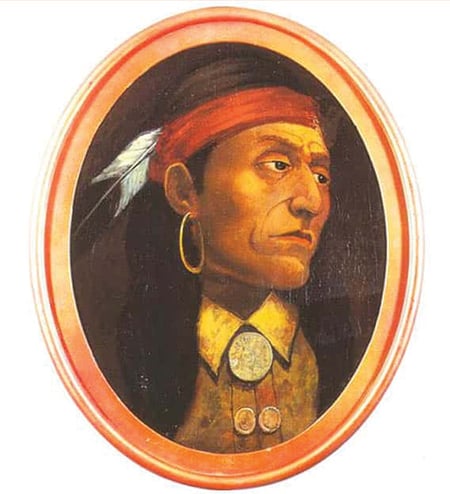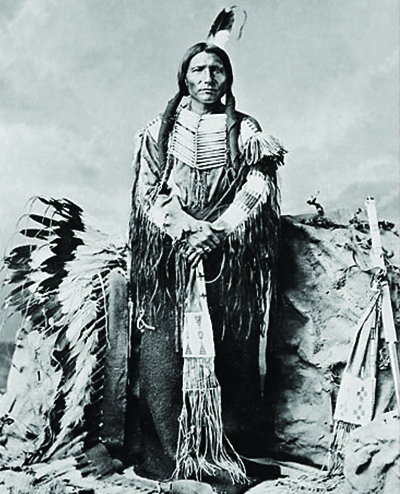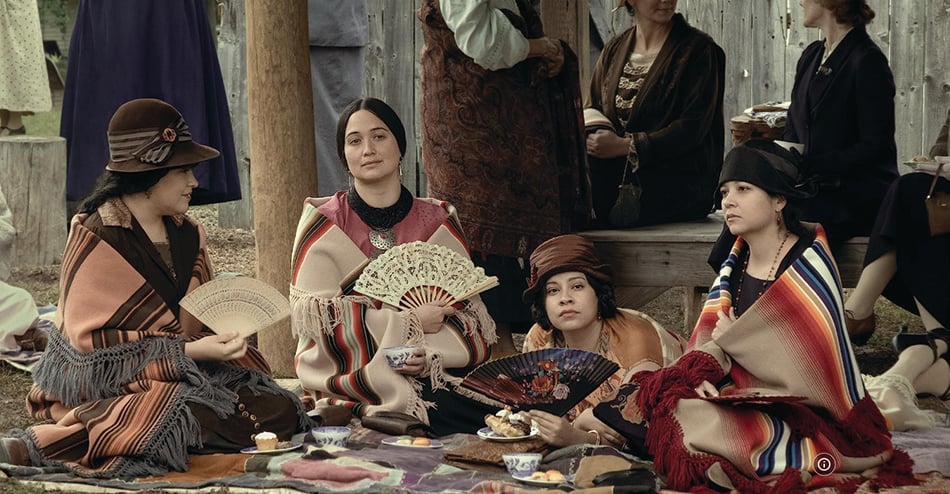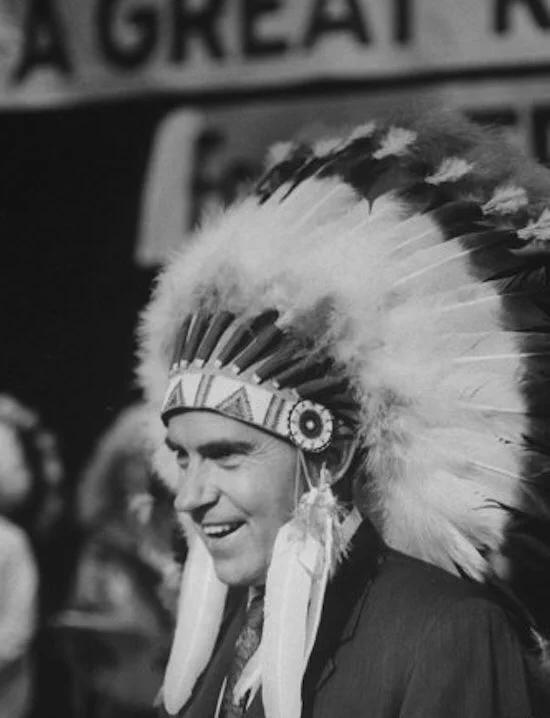One hundred years after the anniversary of Native American citizenship, tribal self-determination appears stronger than ever, but rests on an unstable legal foundation.
Traditional histories of the American continent come from the point of view of the whites who subdued the land and the native peoples who occupied it. Native Americans were treated variously, as obstacles to be overcome, bloodthirsty warriors to be slaughtered, noble savages to be domesticated, or tragic victims to be pitied.
More positive accounts of Native Americans (or American Indians—we will label them synonymously) depicted Indian leaders such as Pontiac or Crazy Horse as heroic resisters and native cultures as essential aids to the survival of early white colonists. Though these portrayals are sympathetic, they restrict the role of Native Americans to supporting actors in the master narrative of white exploration and conquest.
Recent works by American Indian authors attempt to place Indians at the center of the American story. Rather than solely reacting to incursions on their land and culture, native tribes asserted sovereignty and rights to self-determination. Then and now, the tribes have considerable autonomy and agency.

Indians, who led a rebellion
against English settlers in
1763.
This essay is an attempt to integrate recent scholarship, mostly by Native American authors, on the history of U.S. relations with Native Americans. Speaking as a white political scientist born in the 1950s with an interest in federal policy regarding American Indians during the Nixon years, I make no special claim to objectivity or insight in this interpretation. By focusing on the issue of tribal sovereignty, however, I hope to show that Native American resistance, resilience, and perseverance are more prevalent than what is commonly believed.

the Lakota, who fought U.S.
troops in the northern Great
Plains, including in the
Black Hills War of 1876.
According to Yale historian Ned Blackhawk, a Western Shoshone tribal member whose book, The Rediscovery of America: Native Peoples and the Unmaking of U.S. History, won the 2023 National Book Award for Nonfiction, indigenous tribes had a transformative effect on American political development. Their presence, strange and threatening to the newcomers, helped forge a common “American” identity among the white pioneers hailing from many European countries.
Totaling as many as 7 million people in North America when Columbus arrived (estimates vary between 3.5 million and 7 million), native tribes held the balance of power as Europeans fought for control of the Western hemisphere. Actually, Indians had the upper hand collectively, but rivalries between the tribes worked to the advantage of the colonists. Weakened by diseases brought to the “new land” by the immigrants, dependent on whites for metal objects and weapons, and subjected to racist violence, native peoples yielded to the irresistible force of white settlement.
Skeptical of government power but eager to acquire tribal lands, white Americans accepted the stronger national government proposed in the U.S. Constitution. As Blackhawk states, it “was a constitution for colonialism.” Indigenous Americans were not eligible for American citizenship. Congress facilitated land appropriation through treaties with tribes and, when expedient, military force. For example, the Indian Removal Act of 1830, advocated by President Andrew Jackson, coerced Native Americans to lands west of the Mississippi River.
Although Congress exercised plenary power over their fate, Native American tribes retained self-governing powers, recognized by not only 374 separate treaties but also a series of U.S. Supreme Court decisions authored by Chief Justice John Marshall at the time of the Indian Removal Act. In Worcester v. Georgia (1832), Marshall ruled that the Cherokee Nation had the authority to govern itself and those who entered its territory. State laws had no force on Indian land. Indian tribes were under the sole jurisdiction of the federal government and the Constitution, laws, and treaties of the United States.
Following the Civil War, when tribes in the Western territories contested and lost their struggle against removal to reservations, federal authorities attempted to assimilate native peoples into white culture. Missionaries were licensed to convert the natives. Indigenous children were sent to far-off boarding schools like the Carlisle Indian Industrial School in Pennsylvania. As shown in the 2023 Martin Scorsese film Killers of the Flower Moon—developed in association with the Osage Tribe—the corruption-plagued Bureau of Indian Affairs (BIA) treated adult Indians as children, controlling every aspect of their lives.

In 1871, Congress declared an end to the practice of treaty-making. Hoping to disperse tribal communities, Congress enacted the Dawes Act of 1887. Reservation land was divided into small plots allotted to individual indigenous families. The effects were catastrophic. Whereas the Native American population in the U.S. had fallen to 600,000 in 1800 and 350,000 in 1860, the 1900 census count dropped below 240,000. By 1930, 90 million acres, or two-thirds of the Native American land base allotted in 1887, passed out of Indian control.
Throughout the decades of decline, Native Americans adapted. Tribal communities maintained cultural ties and communal traditions. Entering the 1900s, a new generation of native leaders disputed the idea that indigenous peoples were a vanishing race. They opposed assimilationist policies, championed tribal self-rule, and pressed for American citizenship and voting rights. One hundred years ago, on June 2, 2024, Congress enacted the American Indian Citizenship Act.
Later, the administration of President Franklin Roosevelt secured passage of the Indian Reorganization Act (IRA). The IRA ended land allotment, encouraged the drafting of tribal constitutions, emphasized local schooling, recognized cultural autonomy and reestablished what was left of the tribal land base. Though not perfect, the legislation “represented a sea change in Federal Indian policy,” according to Blackhawk.
Starting in 1953, however, Congress made another
attempt at dissolving native communities. Dozens of tribes were “terminated”—denied federal protection and support of rights secured by treaty. Many targeted tribes had received monetary settlements from the Indian Claims Commission for treaty violations. The Republican Congress, led by Senator Arthur Watkins of Utah, withheld disbursement of funds until the recipient tribes agreed to be terminated.
Termination took a heavy toll on Indian Country. Without federal protection, terminated tribes were subject to state taxation. Land loss quickly followed. Moreover, state governments assumed jurisdiction over the social welfare of the native population. To reduce costs, states targeted Native American children for adoption and foster care by non-native caregivers. It is estimated that a quarter to a third of all Indian children were removed from their families during the 1950s and 1960s.
In response, Native Americans mobilized nationally. Indigenous youth staged protest demonstrations, including the 1969-to-1971 occupation of Alcatraz Island, where the federal prison had closed in 1963. Protesters wanted the land returned to native peoples. Other dramatic confrontations followed, including the Election Eve 1972 takeover of the BIA headquarters in Washington, D.C., and, several months later, the siege at Wounded Knee, South Dakota, site of the 1890 U.S. Army massacre of 300 Lakota people.
Though Indian tactics were influenced by the black Civil Rights Movement, native demands were different. Rather than seeking integration with mainstream white society, which was a reminder of assimilation policies, tribes wanted separation. As the scholar and activist Vine Deloria, Jr. put it in his 1969 manifesto, Custer Died for Your Sins, “What we need is a cultural leave-us-alone agreement, in spirit and in fact.”
A “red power” advocacy movement blossomed, consisting of both young activists belonging to the American Indian Movement and elderly traditionalists. They pressured the federal government to honor its treaty commitments and return land to the tribes.
Native leaders pursued more conventional political strategies as well. The National Congress of American Indians, formed in 1946, became a leading voice. The Native American Rights Fund initiated campaigns to secure voting rights, protect natural resources, and ensure tribal sovereignty. Even Hollywood began to portray Indians humanely, reversing decades of Westerns stereotyping Native peoples as ferocious, backward, and doomed.
Native Americans found a friend in President Richard Nixon, who issued a new policy of tribal self-determination without termination in 1970. The Indian Self-Determination and Education Assistance Act of 1975 gave tribes authority to manage their resources and run their own programs, including schools and health care facilities. Moreover, tribes received programs and services from not just the BIA but all parts of the federal government, including Health and Human Services, Housing and Urban Development, and the Justice Department. Native lands in Alaska, New Mexico, and Washington state were returned. Natural resource rights and water rights expanded. Federal protection of terminated tribes was restored.

Why Nixon supported Native causes has always been a fascinating question with complex answers. In addition to pan-Indian political advocacy, tribal communities proved to be competent managers of War on Poverty programs launched by President Lyndon Johnson. Devolving federal power to tribal governments resonated with Nixon’s New Federalism program of devolution to the states.
Nixon also may have regarded Native American policy as an opportunity to upstage liberal rivals slow to respond to Indian demands. Eventually, Democratic leaders such as U.S. Senators Ted Kennedy (D-Mass.), George McGovern (D-S.D.), and Walter Mondale (D-Minn.) proposed their own self-determination bills. They were joined by South Dakota’s junior Democratic senator, James Abourezk, who, as chair of the Senate Indian Affairs Committee, pushed Indian legislation through Congress.
Accused of “benignly” neglecting issues facing African Americans, as well as orchestrating a “Southern Strategy” aimed at courting Southern whites, Nixon could have believed that helping American Indians was more politically acceptable. Indeed, the president’s soft spot for Native peoples allegedly originated from his football coach at Whittier College, Wallace “Chief” Newman, a Luiseno Indian. Newman inspired the skinny third-stringer to never give up. In his memoirs, Nixon reminisced, “I think I learned more from him than any man I have ever known aside from my father.”
Recognition of Native rights continued under Nixon’s Democratic and Republican successors. Jimmy Carter signed the Indian Child Welfare Act of 1978, which recognized tribal interests in keeping Native American families intact. Under Ronald Reagan, tribes gained the power to negotiate with states over the establishment of gaming enterprises, which brought over $40 billion to Indian Country in 2022 alone. Tribal leaders lobbied successfully for the Tribal Self-Governance Act of 1994, creating what Bill Clinton called a “government-to-government” relationship.
Among 21st-century presidents, Barack Obama and Joe Biden held annual conferences with indigenous leaders. Biden appointed Pueblo of Laguna tribe member Debra Haaland as the first Native American to serve as Secretary of Interior, the federal department that houses the BIA. Even Donald Trump, who opposed tribal casinos and prioritized energy development on tribal lands, directed his administration to investigate the crisis of missing and murdered indigenous women. Trump also named Justice Neil Gorsuch, a strong advocate for Native American rights, to serve on the U.S. Supreme Court.
Since 1978, Native communities have been able to petition the Interior Department for federal recognition under the IRA. There are now 574 federally recognized tribes. While Native Americans remain disproportionately impoverished, their numbers have grown. As of July 2022, the Census Bureau estimated the Native population in the U.S. to be 4.3 million as a single race and 7.1 million as mixed Natives.
Importantly, Native peoples are well positioned within the institutions of U.S. government, politics, and law, which should enable them to withstand any further assaults on their self-determination. In addition, the United Nations affirmed tribal rights in its 2007 Declaration on the Rights of Indigenous Peoples. Native American groups are involved in efforts to obtain representation of indigenous peoples in UN proceedings and programs.
Which returns us to the fundamental issue of tribal sovereignty. Though Native Americans have extensive powers of self-government, they remain under the direct authority of Congress. As Maggie Blackhawk, a New York University law professor and Fond du Lac Band of Lake Superior Ojibwe member, argued last year in the Harvard Law Review, Congress can exercise its plenary power to expand or restrict tribal autonomy at any time.
Furthermore, the U.S. Supreme Court, which interprets Indian law, is unpredictable. Writing for the Court in 2023, Justice Gorsuch delivered a major victory for the tribes in Haaland v. Brackeen, upholding the constitutionality of the Indian Child Welfare Act, which gives tribes jurisdiction over Indian child custody, foster care, and adoptions. A year earlier, however, as Maggie Blackhawk explains, the justices ruled in Oklahoma v. Castro-Huerta that state governments could unilaterally extend their criminal laws over crimes committed within Indian Country by non-Indians against Indians. This decision appeared to reverse a principle recognized in Worcester v. Georgia, which presumed state governments could not interfere with tribal nations unless Congress exercised its plenary power to affirmatively allow states to intervene.
Thus, on the one hand, tribal self-determination is strong and getting stronger. On the other hand, the extent and limits of tribal sovereignty remain a mystery.

Leave a Reply